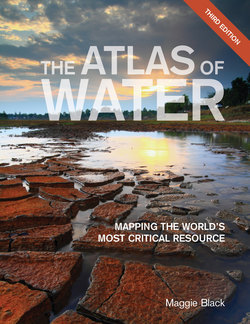Читать книгу The Atlas of Water - Maggie Black - Страница 25
На сайте Литреса книга снята с продажи.
ОглавлениеDwindling Supply
About a fifth of water consumed globally is from underground aquifers. These are replenished by rainwater seeping through soil and rock, but many are being over-exploited. Some non-renewable “fossil water” aquifers are being irreversibly mined. In all parts of the world, groundwater is being withdrawn recklessly. The world’s four top irrigators – China, India, Pakistan and the USA – are all pumping groundwater faster than it is being recharged. Twenty-one of the world’s 37 largest aquifers are beyond their sustainability tipping point. India is the largest groundwater user in the world, relying on it for 60 per cent of its irrigated agriculture. Cheap pumping technology and absence of fees and regulations have encouraged farmers to sink over 21 million tubewells. Some aquifers are now critically over-taxed, and existing wells constantly have to be deepened or replaced. Similarly, in North Africa and the Arabian Peninsula, aquifers created during the last ice age are rapidly being sucked dry. Satellite mapping has shown the Arabian aquifer as the most stressed of all. Many cities in Asia and the Americas rely on groundwater, which is preferred to surface water for drinking because it is less subject to contamination. However, heavy withdrawals lead to saltwater intrusion in coastal areas, turning the water supply brackish and unusable. Exhaustion of aquifers also causes land subsidence. Aquifer recharge is now an important focus of sustainable groundwater management. In some water-scarce rural areas there has been a rediscovery of traditional recharge methods, such as rainwater harvesting, check-dams in stream beds and contour bunds on slopes to contain the run-off from precious downpours.
Q 4 Rising Demand
28
